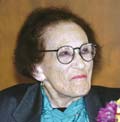WOMEN SHAPING HISTORY:
The Aesthetic Education Conference at Queens
By Joan Baum, Ph.D.
|
|
 |
|
On March 24 the first-ever national conference on Aesthetic Education, co-sponsored by the Equity Studies Research Center at Queens College, CUNY, founded a few years ago, and the Lincoln Center Institute (LCI), a 32-year-old artist-in-residence program that links students and schools according to the philosophy of Aesthetic Education (AE), will take place at the Queens School for Mathematics, Science and Technology (PS/IS 499) located on the QC campus. Both organizations are committed to advancing “social justice” by means of education and the arts. The conference is expected not only to foster understanding of such multi-disciplinary and collaborative education ventures but also to show how AE can encourage all students to learn and to enjoy learning. According to Dr. Amanda Gulla, English Education Program Coordinator at Lehman College, CUNY, one of three conference organizers of “Aesthetic Education: Expanding Notions of Excellence in K-18 Learning Communities” (along with Holly Fairbank, Assistant Director of the Teacher Education Collaborative at LCI and Claire Aronow on the faculty at QC), this timely and significant all-day event will provide a unique opportunity for student teachers, graduate researchers and education faculty from all over the country to discuss work initiated years ago by the legendary AE philosopher-educator Maxine Greene, who will deliver the keynote address.
Most symposia consist of passive delivery of papers. The AE-LCI conference turns on demonstration and feedback. A performance of Hans Christian Anderson’s “The Snow Queen” by the Hudson Vagabond Puppets will serve as an opportunity to learn how to tease out the play’s social message and generate relevant activities. Maxine Greene has described AE as an “intentional undertaking designed to nurture appreciative, reflective, cultural, participatory engagements with the arts by enabling learners to notice what there is to be noticed, and to lend works of art their lives in such a way that they can achieve them as variously meaningful.” This “deep noticing” begins before students hear a concert, see a play or go on a field trip to a museum. The AE/LCI conference will show teachers how preparation and follow-up can be designed and recommend materials.
Professor Gulla’s own “journey” as a teacher began years ago when by chance she found herself before a class in an inner-city school where her father, on sabbatical, was an art teacher. She loved the experience, and it inspired her to want to be a teacher. But later on, with a Ph.D. in English Education from NYU, she remembers how alone she felt in her first position in a middle school in the South Bronx, “thrown to the wolves, given no help.” With pluck and luck she managed, but she became increasingly aware that there were methods out there, and mentors, who could have made a difference. Courses with the New York Writing Project and an inspiring stint teaching elementary school with a wonderful principal, Faye Pallen, convinced her that some pedagogies were more effective than others, more imaginative, more embracing of the arts and sciences, and more likely to make a lasting impression—on both teachers and students. And so she determined that her own professional development would focus on teacher education, under the aegis of AE.
Evaluation of AE does not lend itself to standardized test measures, but if efficacy can be understood as student engagement, then, says Amanda Gulla, AE works and works well. In fact, it worked very well for her the night before Education Update caught up with her. She had been demonstrating “deep noticing” with her graduate students, a class of 20, 18 of whom are NYC Teaching Fellows. She had selected the poem, “Thirteen Ways of Looking at a Blackbird” by Wallace Stevens, in order to show that youngsters can be involved with a complicated text (or a complex art work, dance, drama or piece of music). She moved from having the group “notice” particular language, to “jamming” on those words and, then, settling on one poetic line and illustrating it as a visual, on paper. The activity served as a springboard to the students’ writing their own poems. Both texts and visuals were posted for all to see and discuss.
In addition to helping organize the AE-LCI conference Professor Gulla and two colleagues will lead a session on “Aesthetic Education and Action Research,” about a faculty development grant between Lehman and Bronx Community College. Other conference listings indicate a wide variety of topics, including A Response to Life After Hurricane Katrina, The Upper West Side Architectural Project, Deconstructing and Re-Constructing Aesthetic Education in the Mathematics Education Classroom, Movement Learning Theory, and a panel discussion with specialists from the Bank Street College of Education, the Guggenheim Museum, Hunter College, Teachers College and LCI. For information: call Patricia Taylor at QC: (718) 997-5218.#
